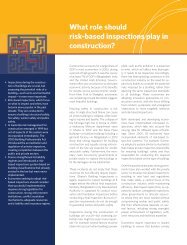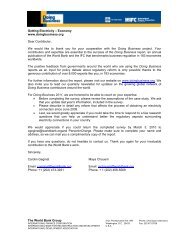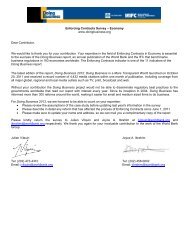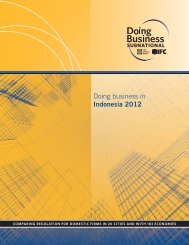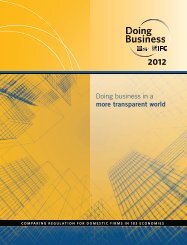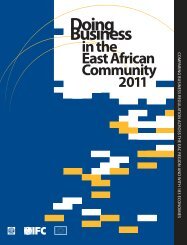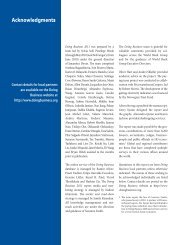Economy Profile: Burundi - Doing Business
Economy Profile: Burundi - Doing Business
Economy Profile: Burundi - Doing Business
You also want an ePaper? Increase the reach of your titles
YUMPU automatically turns print PDFs into web optimized ePapers that Google loves.
<strong>Doing</strong> <strong>Business</strong> 2013<br />
<strong>Burundi</strong><br />
95<br />
RESOLVING INSOLVENCY<br />
A robust bankruptcy system functions as a filter,<br />
ensuring the survival of economically efficient<br />
companies and reallocating the resources of<br />
inefficient ones. Fast and cheap insolvency<br />
proceedings result in the speedy return of<br />
businesses to normal operation and increase<br />
returns to creditors. By improving the expectations<br />
of creditors and debtors about the outcome of<br />
insolvency proceedings, well-functioning<br />
insolvency systems can facilitate access to finance,<br />
save more viable businesses and thereby improve<br />
growth and sustainability in the economy overall.<br />
What do the indicators cover?<br />
<strong>Doing</strong> <strong>Business</strong> studies the time, cost and outcome<br />
of insolvency proceedings involving domestic<br />
entities. It does not measure insolvency<br />
proceedings of individuals and financial<br />
institutions. The data are derived from survey<br />
responses by local insolvency practitioners and<br />
verified through a study of laws and regulations as<br />
well as public information on bankruptcy systems.<br />
The ranking on the ease of resolving insolvency is<br />
based on the recovery rate, which is recorded as<br />
cents on the dollar recouped by creditors through<br />
reorganization, liquidation or debt enforcement<br />
(foreclosure) proceedings. The recovery rate is a<br />
function of time, cost and other factors, such as<br />
lending rate and the likelihood of the company<br />
continuing to operate.<br />
To make the data comparable across economies,<br />
<strong>Doing</strong> <strong>Business</strong> uses several assumptions about the<br />
business and the case. It assumes that the<br />
company:<br />
• Is a domestically owned, limited liability<br />
company operating a hotel.<br />
• Operates in the economy’s largest business<br />
city.<br />
WHAT THE RESOLVING INSOLVENCY<br />
INDICATORS MEASURE<br />
Time required to recover debt (years)<br />
Measured in calendar years<br />
Appeals and requests for extension are<br />
included<br />
Cost required to recover debt (% of debtor’s<br />
estate)<br />
Measured as percentage of estate value<br />
Court fees<br />
Fees of insolvency administrators<br />
Lawyers’ fees<br />
Assessors’ and auctioneers’ fees<br />
Other related fees<br />
Recovery rate for creditors (cents on the<br />
dollar)<br />
Measures the cents on the dollar recovered<br />
by creditors<br />
Present value of debt recovered<br />
Official costs of the insolvency proceedings<br />
are deducted<br />
Depreciation of furniture is taken into<br />
account<br />
Outcome for the business (survival or not)<br />
affects the maximum value that can be<br />
recovered<br />
• Has 201 employees, 1 main secured creditor<br />
and 50 unsecured creditors.<br />
• Has a higher value as a going concern—and<br />
the efficient outcome is either reorganization<br />
or sale as a going concern, not piecemeal<br />
liquidation.



